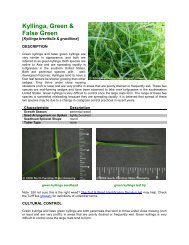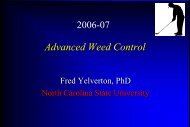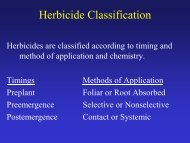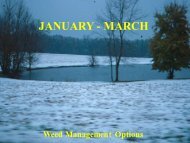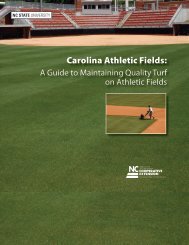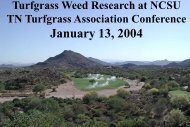General Landscape Irrigation Audit Procedures - TurfFiles
General Landscape Irrigation Audit Procedures - TurfFiles
General Landscape Irrigation Audit Procedures - TurfFiles
You also want an ePaper? Increase the reach of your titles
YUMPU automatically turns print PDFs into web optimized ePapers that Google loves.
Following is the general approach to conducting catch can tests:1. Turn on the irrigation system, one zone at a time, to locate and mark sprinkler heads.2. Starting with zone 1, layout catch devices only on the part of the landscape covered byzone 1. Catch devices should be placed in a grid-like pattern throughout the zone toachieve an accurate representation of sprinkler performance.Note: Try not to place catch devices too close to sprinkler heads to avoid altering spraypatterns.3. Turn on zone 1, allowing water to partially fill the catch devices. Keep track of thenumber of minutes that the zone is allowed to operate.4. After a measurable amount of water has fallen, measure the depth of water (in inches)contained in each device using a ruler. (It is recommended that the ruler measure in“tenths” of inches). Record these values on a data sheet. Also record how long (inminutes) the zone was operated. If catch containers do not have „parallel sides”, thenwater volume may need to be measure and then corrected for container opening area.5. Repeat steps 1-4 above for each remaining zone on the system.Using the data from catch can testing, we can now determine the precipitation rates for eachindividual zone on the irrigation system. The simple equation for calculating precipitation rate isgiven below:Precipitation rate = (average catch can depth run time ) x 60Where:Precipitation rate is in inches per hourAverage catch can depth is in inchesNote if containers do not have parallel sides then it is best to measure volume (in mLwhich is equivalent to cm 3 ) and determine depth by dividing volume by area (in cm 2 )ofthe container‟s opening.Remember: Area of circle = πr 2 & 1 inch = 2.54 cmOur catch cups have an area of 44.18 cm 2 , so in this case 56.10 mL = ½ inch water<strong>Irrigation</strong> SchedulingThe answer to the question, “when do I irrigate and how long?” has been based on assumptionsand generalizations in regards to sprinkler system performance and plant water requirements.<strong>Audit</strong>s replace many of the assumptions we make in irrigation scheduling. With irrigationauditing, we customize our irrigation schedules based upon on catch can results. Rather than2
using the longtime recommendation of “fifteen minutes, three times per week”, run times can beadjusted for individual zones based on measured precipitation rate.Determining when to irrigate should be based upon the depth of the plant‟s root zone and thetype of soil therein. Together, root depth and soil type define the amount of water that isavailable for plant use. A six-inch clay soil, for example, will hold more water that will six inchof sand. Thus, the number of irrigations per week will be less in the clay, though the amount ofwater the plant needs will remain the same. Root depth also influences irrigation frequency.Shallow rooted turfgrass, for example, will require more frequent irrigations than will a turfgrasswith a deeper root zone.The first step in determining how long to irrigate is to first determine how much water that youshould apply each irrigation event. Plant water requirements vary significantly in urbanlandscapes due to the variety of plant species, maintenance practices and microclimates. Waterrequirements also vary with climate trends and rainfall patterns. Turfgrass, which is generallyassumed to be the highest water user, requires up to 1-inch per week during the summer with lessin the spring and fall. Once it is determined how much water (in inches) is needed eachirrigation, the conversion to zone run time is simple. The following equation is used to determinezone run times:Run Time per <strong>Irrigation</strong> = (Targeted irrigation depth Zone precipitation rate) x 60Where:Run Time per <strong>Irrigation</strong> in minutesTargeted irrigation depth in inchesZone precipitation rate in inches per hour<strong>Irrigation</strong> <strong>Audit</strong> Datasheet adapted from aggiehort agentdemo.3
Broken HeadsMis-aligned HeadsSunken HeadsHigh PressureLow PressureMixed Head TypeLANDSCAPE IRRIGATION AUDIT DATASHEETSite:Date/Time:<strong>Audit</strong>or:Site InspectionZone #123456CommentsCATCH CAN RESULTSZone # 1 2 3 4 5 6Test Run Times (minutes)Catch Can Dept (inches)Precipitation Rate (in/hr) = AverageCan Depth (in) ÷ Test Run Time(minutes) x 60Precipitation Rate (inches/hour)4
QUANTIFYING IRRIGATION WATER USEDetermining Inches of Water Applied per <strong>Irrigation</strong>Inches Applied per <strong>Irrigation</strong> = (Run time x Precipitation rate) 60Example:Zone 1 is set to operate 30 minutes. According to the catch can test, Zone 1 has a precipitationrate of 0.5 inches per hour.Inches Applied per <strong>Irrigation</strong> = (30 minutes x 0.5 inches per hour)60 = 0.25 inchesDetermining Inches of Water Applied per WeekInches Applied per Week = Inches Applied per <strong>Irrigation</strong> x Number of <strong>Irrigation</strong>s per WeekExample:Zone 1 applies 0.25 inches per irrigation. Zone 1 is set to operate three days per week.Inches Applied per Week = 0.25 inches per irrigation x 3 irrigations per week = 0.75 inchesConverting Inches per <strong>Irrigation</strong> to Gallons per <strong>Irrigation</strong>Gallons per <strong>Irrigation</strong> = Inches per <strong>Irrigation</strong> x <strong>Landscape</strong> Area x 0.6234Example:Zone 1 applies 0.25 inches per irrigation. The area covered by Zone 1 is 1000 square feet.Gallons per <strong>Irrigation</strong> = 0.25 inches per irrigation x 1000 square feet x 0.6234 = 155.85 gallonsConverting Inches per Week to Gallons per WeekGallons per Week = Inches per Week x <strong>Landscape</strong> Area x 0.6234Example:Zone 1 applies 0.75 inches per week. The area covered by Zone 1 is 1000 square feet.Gallons per week = 0.75 inches per week x 1000 square feet x 0.6234 = 467.55 gallonsOther Conversions:Gallons to Inches: Gallons <strong>Landscape</strong> Area 0.6234 = InchesGallons to 100 Cubic Feet: Gallons 748 = ccf325,851 gallons = one acre-foot of water27,154 gallons = one acre-inch of water5





